Calathea is a famous species of the family Marantaceae, grown indoors because of its stunning foliage patterns and vivid colors. Calatheas are classified as flowering plants as they bloom graciously in the wild; however, it is rare to see Calatheas blooming indoors except for a few species.
Calatheas are tropical plants and originate from the rainforests of the Amazon. Calathea plants are moved to the genus Goeppertia, and now they are botanically known as Goeppertia. Calatheas have more than 300 accepted species, with the following most popular ones;
Essential Products:
How do you care for Calathea?
Calathea care requires a humid atmosphere with moist soil throughout the year. Furthermore, they grow tremendously in shaded areas with warm surroundings. Here we will provide you with a brief guideline on keeping your Calathea happy indoors.

Bringing Calathea plant home
After receiving your plant or bringing it from the nursery few things you must remember before putting it on the home shelf.
Please, check your plant keenly, especially leaves, as pests are sapsuckers and always hide the underside of the leaf.
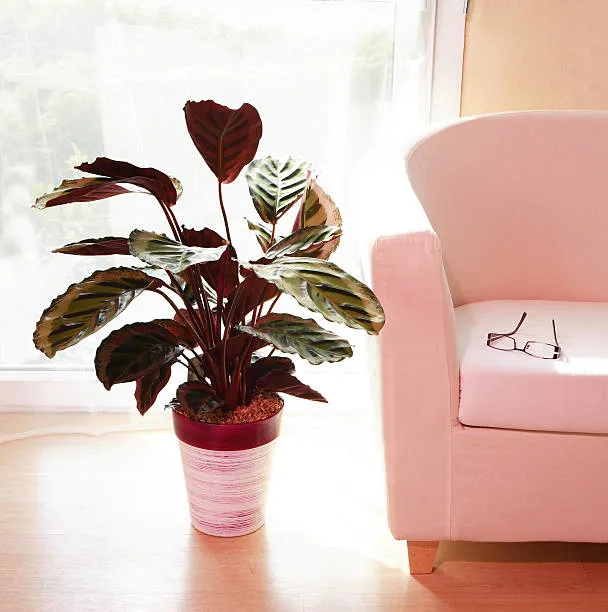
Please place it in a separate room for at least two weeks as the bacterial and fungal disease takes time to show its sign.
This precautionary measure to keep new plants isolated is necessary to save your other indoor plants from any disease or pest.
If no sign of pest or disease is found, you are free to display this beauty in any spot of your home.

Where should I place my Calathea?
Native to the Brazilian rain forest, Calathea loves to thrive in the same shaded area as it is used to flourish under diffused light of tall trees.
They can’t tolerate high-intensity light or direct sunlight; however, they can stand early morning direct sun rays.
To get sufficient diffused light, place it a few feet away in front of the east or west-facing window with curtains or blinds on it.

Humidity and Temperature Requirements
Calathea prefers high humid atmosphere to grow, the minimum humidity level must be 50% in its surrounding, but a 60% to 70 % level will be perfect for its bloom.
Place a humidifier near the Calathea plants or employ other DIY techniques to increase the humidity.
The average temperature at which Calathea remains happy is 65°F-85°F, and they start losing their vigour in a cold atmosphere. Furthermore, Calatheas cannot tolerate temperature variation; therefore, make a permanent spot away from cold drafts like ACs and windows.

Why my Calathea is not blooming?
Although Calatheas are categorized as flowering plants, they require utmost care and perfect climatic conditions to bloom indoors.
Calatheas are adored as indoor plants because of their gorgeous foliage; however, few species of Calatheas like Calathea Crocata, Calathea Warscewiczii and Calathea Loeseneri produce beautiful blooms with little care.

How often do you water Calathea?
When it comes to water, it’s a tricky part of Calathea care.
Calathea requires moist soil, but it shall not be overly wet.
Remember to water your Calathea when the upper two-inch potting soil is dry; check it manually by finger or use a soil moisture meter to let you know when to water the plant. Furthermore, the growing season from spring to summer requires more water than winter. Water it twice in summer and once a week in winter.
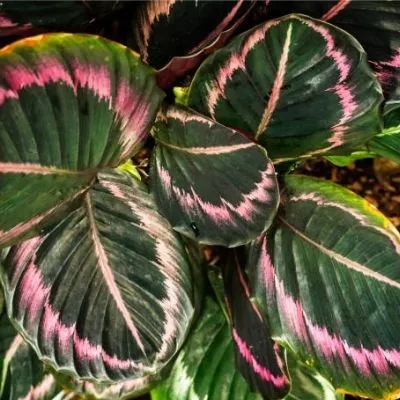
Water calathea when pot soil 2-inch upper layer is dry
What kind of water do you use for Calathea?
The best option for watering is to use rainwater. Calatheas are susceptible to damage from minerals present in tap water which can cause browning on the leaves’ edges. Use distilled water if your tap water is high in minerals.
Note: Please use water at room temperature for watering.

What’s the best soil for Calatheas?
Calathea plants love growing in moist soil; therefore, choose a soil with excellent moisture-retaining capability. However, overly wet soil is harmful to plant health and can invite fungal attacks.
When choosing a readymade soil, we recommend using the African Violet soil mix available in the market as it is suitable for Calatheas.
Use peat moss, perlite, orchid bark with regular houseplant potting soil if you intend to make your soil mix. These ingredients enhance the drainage quality, maintain soil moisture, and provide nutrients.

Should I cut dead leaves off Calathea?
Periodic pruning will maintain plants’ shape and size. Please cut away all the yellow, brown, or damaged leaves to improve the plant’s look and promote new growth.
Always use clean, sterilized tools (Pruning Shear) for pruning.

Fertilizer requirements of Calatheas
Calathea plants require extra nutrients every month during the growing seasons of spring and summer.
We recommend using a balanced 2-2-2 houseplant fertilizer in liquid or slow-release form.

Fertilizers provide extra nutrients for growth
Make a dilute solution and water your plant before applying fertilizer. Please avoid overfertilization.

When to repot your Calathea plant?
Calathea plants are moderately fast-growing plants and require repotting every two years or when you see plants with stunted growth. In addition, roots coming out from pot soil or drainage hole also indicates that Calathea requires more space for roots.
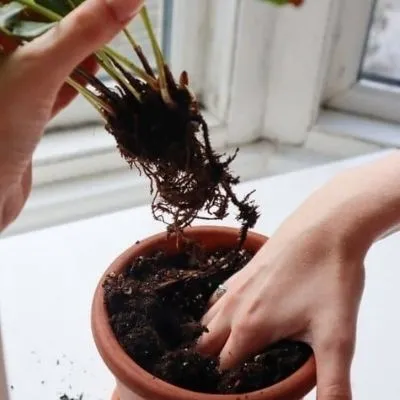
Re-potting provides extra space for roots growth
For repotting your plant, follow these steps

How to Propagate your Calathea plant?
Propagation is a method to make new plants through seed, stem, leaf, or roots.
Calathea plants are successfully propagated through the roots division of the mother plant.
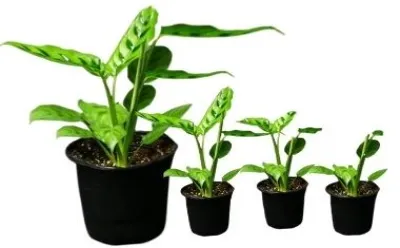
Propagation of Calathea
For successful propagation of Calathea, you need;
First, pull out the mother plant carefully with soft hands and remove the excess soil from the roots by shaking them. Next, make a section of the roots and select a stem with one or two leaves and a bunch of roots. Snip that stems from the mother plant with a sharp knife or scissor and plant in the new pot. Finally, water your baby plant and put it in a shady place; when new growth starts, transfer the baby plant to a normal setting for stable growth.

Is Calatheas safe for pets?
According to global analytics, Calatheas are safe for all pets and children, so you don’t have to worry when your cat or child goes near one or accidentally chews it.

Pests, diseases and Common Queries
Pests
The pests that usually attack Calathea plants are spider mites, mealybugs, fungus gnats, and thrips. These are all sapsucker and make colonies on the backside of the leaves.
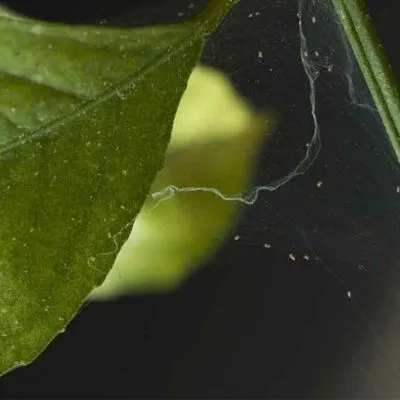
Spider mite web on leaf and stem
Use the sticky traps to stop the spread of fungus gnats. To cure the pests feeding on leaves, apply Neem oil with a soft cloth on infected leaves, or spray pesticides.
Diseases
Root rot occurs due to overwatering. Roots cannot live long in soggy soil, and they start rotting resulting in the yellowing of leaves.
In addition, a bacterial leaf spot can be seen if your plant foliage remains wet after misting. The medication for Pseudomonas bacteria is to wash out the leaf with antibacterial soap and always wipe out extra water from the leaves after misting to protect the plant from the next bacterial infection.
Why my Calathea plant is wilting and curling its leaves?
Underwatered or low humidity levels might be the reasons; if potting soil is dry more than 2-inch-deep, water immediately and increase the humidity level if required.
Is Calatheas hard to care for?
Most Calathea species are a bit hard to take care of. Calatheas are very particular regarding their watering requirements. The soil shall remain moist; however, soggy soil will invite fungal diseases; therefore, you have to find the right balance for soil type and watering frequency.
Why are Calathea plant leaves turning yellow or brown?
Overwatering is the reason which is making the pot soil soggy and plant roots are not getting enough air to breathe. Change the saturated soil with moist soil.
Why are my Calathea plant leaves developing spots?
Calathea is sensitive to the chemicals present in the tap water, so water your plant with distilled or filtered water to avoid leaf spots. If you do not clean the leaf drops from the leave after misting, the fungus will make a home at that point, so always wipe away excess water from the leaves.
How do I keep Calathea happy?
Grow the Calathea plants in a humid and warm climate, with moisture-retaining and well-draining soil. Place the plant in low to medium diffused light and fertilize during growing seasons to keep the plant happy and thriving.
Why do Calathea leaves close at night?
The leaves of Calathea remain open during the day to absorb maximum moisture and light, whereas they close at night to help them hold the water by closing instead of evaporating.
Are Calathea good for bedroom?
Calatheas are an excellent option for the bedroom because of their gorgeous, patterned leaves and oxygenating properties. The Calathea plants provide a soothing environment and are also a natural air purifier and cleanser.
Is Calathea a prayer plant?
Calatheas are photoperiodic, which means the leaves of Calatheas change their position with respect to day and night changes. Many people call them a prayer plant; however, the actual prayer plant is another family member Maranta Leuconeura having true praying hand movement.
Should I give my Calathea a shower?
Calatheas are humidity-loving plants, and they originate from heavy rainfall areas of the Amazon; therefore, they will love a shower with lukewarm water.


